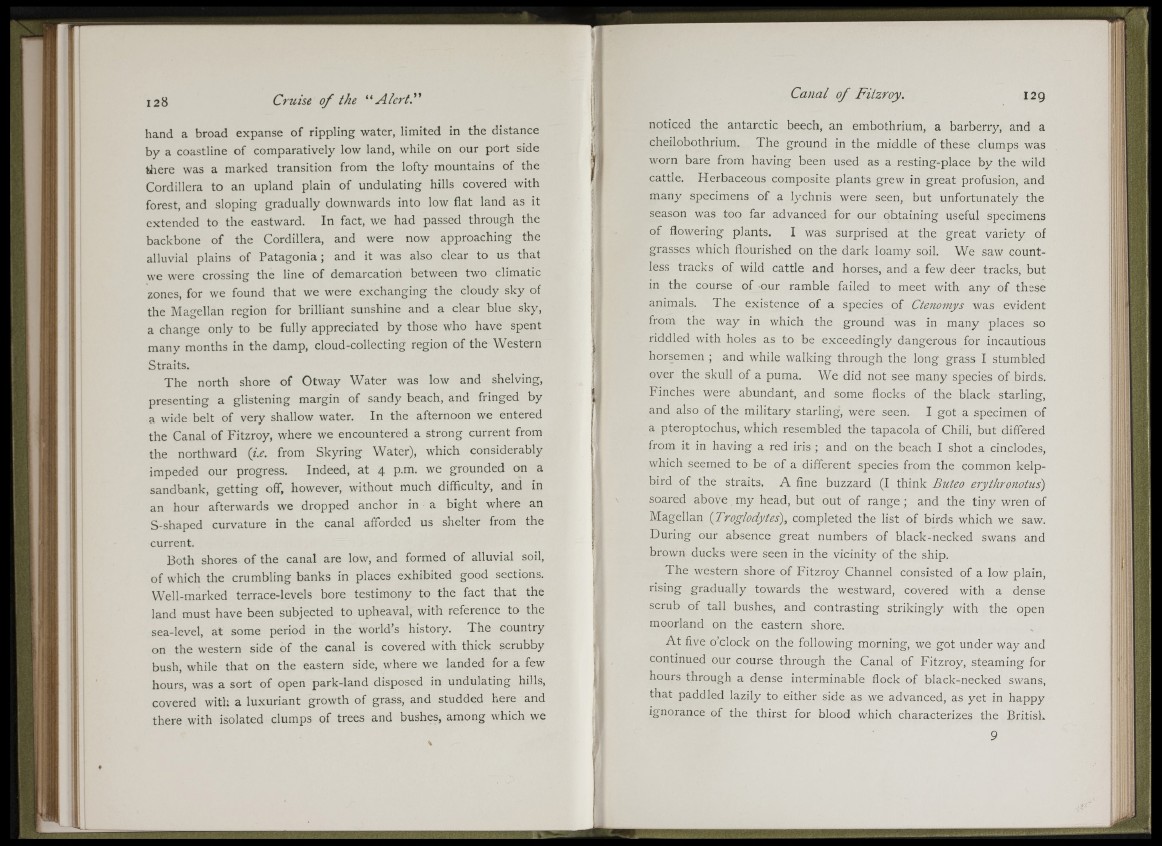
i , S:!
m
li
k'" •
i :
m
■-a
il
<
hand a broad expanse of rippling water, limited in the distance
by a coastline of comparatively low land, while on our port side
tJiere was a marked transition from the lofty mountains of the
Cordillera to an upland plain of undulating hills covered with
forest, and sloping gradually downwards into low flat land as it
extended to the eastward. In fact, we had passed through the
backbone of the Cordillera, and were now approaching the
alluvial plains of Patagonia ; and it was also clear to us that
we were crossing the line of demarcation between two climatic
zones, for we found that we were exchanging the cloudy sky of
the Magellan region for brilliant sunshine and a clear blue sky,
a change only to be fully appreciated by those who have spent
many months in the damp, cloud-collecting region of the Western
Straits.
The north shore of Otway Water was low and shelving,
presenting a glistening margin of sandy beach, and fringed by
a wide belt of very shallow water. In the afternoon we entered
the Canal of Fitzroy, where we encountered a strong current from
the northward {i.e. from Skyring Water), which considerably
impeded our progress. Indeed, at 4 p.m. we grounded on a
sandbank, getting off, however, without much difficulty, and in
an hour afterwards we dropped anchor in a bight where an
S-shaped curvature in the canal afforded us shelter from the
current.
Both shores of the canal are low, and formed of alluvial soil,
of which the crumbling banks in places exhibited good sections.
Well-marked terrace-levels bore testimony to the fact that the
land must have been subjected to upheaval, with reference to the
sea-level, at some period in the world’s history. The country
on the western side of the canal is covered with thick scrubby
bush, while that on the eastern side, where we landed for a few
hours, was a sort of open park-land disposed in undulating hills,
covered with a luxuriant growth of grass, and studded here and
there with isolated clumps of trees and bushes, among which we
noticed the antarctic beech, an embothrium, a barberry, and a
cheilobothrium. The ground in the middle of these clumps was
worn bare from having been used as a resting-place by the wild
cattle. Herbaceous composite plants grew in great profusion, and
many specimens of a lychnis were seen, but unfortunately the
season was too far advanced for our obtaining useful specimens
of flowering plants. I was surprised at the great variety of
grasses which flourished on the dark loamy soil. We saw countless
tracks of wild cattle and horses, and a few deer tracks, but
in the course of our ramble failed to meet with any of these
animals. The existence of a species of Ctenomys was evident
from the way in which the ground was in many places so
riddled with holes as to be exceedingly dangerous for incautious
horsemen ; and while walking through the long grass I stumbled
over the skull of a puma. We did not see many species of birds.
Finches were abundant, and some flocks of the black starling,
and also of the military starling, were seen. I got a specimen of
a pteroptoclius, which resembled the tapacola of Chili, but differed
from it in having a red iris ; and on the beach I shot a cinclodes,
which seemed to be of a different species from the common kelp-
bird of the straits. A fine buzzard (I think Buteo erythronotus)
soared above my head, but out of range ; and the tiny wren of
Magellan {Troglodytes'), completed the list of birds which we saw.
During our absence great numbers of black-necked swans and
brown ducks were seen in the vicinity of the ship.
The western shore of Fitzroy Channel consisted of a low plain,
rising gradually towards the westward, covered with a dense
scrub of tall bushes, and contrasting strikingly with the open
moorland on the eastern shore.
At five o’clock on the following morning, we got under way and
continued our course through the Canal of Fitzroy, steaming for
hours through a dense interminable flock of black-necked swans,
that paddled lazily to either side as we advanced, as yet in happy
ignorance of the thirst for blood which characterizes the British
9
■iii
bk.;.